OSPP参与记录
前言
今年毕业前申请参与了2024年的开源之夏(OSPP),是一次很宝贵的开源项目经验,最终成功结项。写这篇博客以此记录留存。
本博客记录的内容截至日期为 2024:09:30,最终方案相比本文有变动,例如放弃 jprotobuf 方案、重构 Grpc 调用模块等。具体详见:https://github.com/alibaba/arthas/pull/2914
项目申请书
项目背景
Arthas 是一个 Java 诊断工具,它允许开发人员在无需修改应用程序代码的情况下,动态地监视和解决生产环境中 Java 应用程序的问题。目前 Arthas 主要是通过交互式的命令行提供服务,此外也提供了 http api。但是 http api 比较简陋,预期通过grpc server提供服务。但是官方的 grpc 实现依赖多、运行时内存占用高,本项目旨在提供一种低资源消耗的 grpc 实现,需要支持 stream 并尽量减少外部依赖。
项目主要内容
- 实现低资源消耗的 grpc 协议,需要尽量减少外部依赖,并支持双向 stream。
- 基于上述 grpc 协议,提供一个简单的Arthas服务的实现,比如查看Jvm System Properties。
- 实现 protobuf 的编译代码生成器,优先级不高,先用官方的生成代码也可以接受。
项目相关文档
- github issue地址:https://github.com/alibaba/arthas/issues/2349
- arthas 官方文档:https://arthas.aliyun.com/doc
其他开源 grpc 实现参考:
- dubbo 的 triple 实现:https://github.com/apache/dubbo/tree/3.2/dubbo-rpc/dubbo-rpc-triple
- armeria 的 grpc 实现:https://armeria.dev/docs/server-grpc
- wire 的 grpc 实现:https://github.com/square/wire
项目方案概述
参考各开源项目的 grpc 实现后,本项目方案设计如下:
- 服务端和客户端使用 protobuf 作为IDL
- 客户端实现可以由用户自行决定,只要符合官方 grpc 协议即可,例如可以参考 grpc-java 官方的 client 请求实例
- 服务端不依赖 netty java 的官方实现(即 grpc-netty),因此需要实现两个部分
- stub 接口代码生成:参考 wire,读取 protobuf 后手动实现(可选,前期可以先手动写服务端的 stub 接口)
- grpc 实现:参考 grpc-netty 官方实现,主要涉及对 http2 frame 的操作
stub 代码生成
此操作在编译期完成,预计需要在编译期依赖 wire 读取 protobuf schema,然后手动拼接文件。
参考 opentelemetry-java 中关于生成 stub 接口代码的实现:https://github.com/open-telemetry/opentelemetry-java/blob/v1.22.0/buildSrc/src/main/kotlin/io/opentelemetry/gradle/ProtoFieldsWireHandler.kt
可以使用 maven-compiler-plugin 来指定 maven 编译期间执行上述生成过程。
gprc 实现
grpc 的实现参考 grpc-netty 的实现。grpc 本质上是 http2。

要实现 grpc,就需要实现 netty 中处理 http2 请求的一些组件:
- Http2ConnectionDecoder:
- 负责解析 HTTP/2 帧,并将它们转换为 gRPC 消息。
- 通常位于 Netty 的
ChannelPipeline中,用于处理接收到的 HTTP/2 帧。
- Http2ConnectionHandler:
- 负责处理 gRPC 消息,包括序列化和反序列化。
- 通常位于 Netty 的
ChannelPipeline中,用于处理 gRPC 消息。
- Http2ConnectionListener:
- 负责处理 HTTP/2 连接的生命周期事件,如设置和更改流状态。
- 通常位于 Netty 的
ChannelPipeline中,用于处理 HTTP/2 连接的状态变化。
参考 grpc-netty 的实现,其中就实现了这些组件。
以读取 data frame 为例,grpc-netty 中通过 io.grpc.netty.NettyServerHandler.FrameListener 实现了 io.netty.handler.codec.http2.Http2FrameAdapter,其中的 onDataRead 方法就会在读取 data frame 时触发,其简略代码如下:
io.grpc.netty.NettyServerHandler#onDataRead
1 | private void onDataRead(int streamId, ByteBuf data, int padding, boolean endOfStream) |
io.grpc.internal.AbstractServerStream.TransportState#inboundDataReceived
1 | public void inboundDataReceived(ReadableBuffer frame, boolean endOfStream) { |
io.grpc.internal.AbstractStream.TransportState#deframe
1 | protected final void deframe(final ReadableBuffer frame) { |
io.grpc.internal.MessageDeframer#deframe
1 | public void deframe(ReadableBuffer data) { |
io.grpc.internal.MessageDeframer#deliver
1 | private void deliver() { |
io.grpc.internal.MessageDeframer#processBody
1 | private void processBody() { |
当接收到 data frame 后,grpc 的处理方式是将其放入缓冲区中,最终 data frame 结束后,会调用 processBody() 处理 body:从缓冲区中读出 inputStream,然后触发消息。
对 http2 frame 的操作可以参考 grpc-netty 实现,本方案主要修改点在于 processBody,需要替换为针对 stub 生成代码的实现,预计会考虑反射调用的处理。
此外,对于 http2 frame 的操作,netty 还给出了更好的方式,后续可以考虑:Http2FrameCodecBuilder (Netty API Reference (4.1.110.Final))
规划
- 阶段一:研究 netty 实现 grpc 协议(7.1 - 8.15)
- 第一周:阅读 grpc-netty 源码,了解 netty 对于 http2 的封装。
- 第二周、第三周:使用 netty 实现 grpc 协议一元调用。
- 第四周:继续参考 grpc-netty 源码,了解双向流、异常处理的实现。
- 第五周、第六周:完成 grpc 双向流的实现。
- 阶段二:研究 stub 代码生成部分(8.15 - 8.30)
- 第一周:阅读 opentelemetry-java 相关实现,了解 protobuf 的 schema、了解 java 代码生成。
- 第二周:实现 stub 代码生成。
- 阶段三:使用 grpc 实现 arthas 中的部分功能(9.1 - 9.15)
- 第一周:阅读 arthas 的相关源码,了解其实现。
- 第二周:利用 gprc 实现其中的部分功能。
- 阶段四:完成结项报告和 pr/mr 提交(9.16 - 9.30)
- 第一周:为项目编写 readme 文档,便于后续维护修改。
- 第二周:完成结项报告和 pr/mr 提交。
其他
这是我第一次参与到大型的开源项目中来,感谢 ospp 提供了这个机会,十分期待能够给开源社区提供贡献,并积累相关经验,学习更多知识。另外我对 arthas 非常感兴趣,平时的日常开发中也经常使用,如果以后有机会,希望能够继续投入到开源社区的工作中,为开源社区做贡献。
结项报告
项目信息
项目介绍
Arthas 是一个 Java 诊断工具,它允许开发人员在无需修改应用程序代码的情况下,动态地监视和解决生产环境中 Java 应用程序的问题。目前 Arthas 主要是通过交互式的命令行提供服务,此外也提供了 http api。但是 http api 比较简陋,预期通过grpc server提供服务。但是官方的 grpc 实现依赖多、运行时内存占用高,本项目旨在提供一种低资源消耗的 grpc 实现,需要支持 stream 并尽量减少外部依赖。
本项目主要完成了以下内容
- 实现低资源消耗的 grpc 协议,需要尽量减少外部依赖,并支持双向 stream。
- 实现 protobuf 的序列化和反序列化
方案描述
参考各开源项目的 grpc 实现后,本项目方案设计如下:
- 服务端和客户端使用 protobuf 作为 IDL
- 客户端实现可以由用户自行决定,只要符合官方 grpc 协议即可,例如可以参考 grpc-java 官方的 client 请求实例
- 服务端不依赖 netty java 的官方实现(即 grpc-netty),因此需要实现两个部分
- protobuf 的序列化和反序列化,参考 protobuf
- grpc 的请求处理,包括一元请求和双向流请求,参考 grpc-netty
时间规划
- 阶段一:研究 netty 实现 grpc 协议(7.1 - 8.15)
- 第一周:阅读 grpc-netty 源码,了解 netty 对于 http2 的封装。
- 第二周、第三周:使用 netty 实现 grpc 协议一元调用。
- 第四周:继续参考 grpc-netty 源码,了解双向流、异常处理的实现。
- 第五周、第六周:完成 grpc 双向流的实现。
- 阶段二:研究 stub 代码生成部分(8.15 - 8.30)
- 第一周:阅读 opentelemetry-java 相关实现,了解 protobuf 的 schema、了解 java 代码生成。
- 第二周:实现 stub 代码生成。
- 阶段三:使用 grpc 实现 arthas 中的部分功能(9.1 - 9.15)
- 第一周:阅读 arthas 的相关源码,了解其实现。
- 第二周:利用 gprc 实现其中的部分功能。
- 阶段四:完成结项报告和 pr/mr 提交(9.16 - 9.30)
- 第一周:为项目编写 readme 文档,便于后续维护修改。
- 第二周:完成结项报告和 pr/mr 提交。
项目进度
已完成工作
截至930,该项目已完成:
- protobuf 的序列化和反序列化实现及其单元测试
- 解析 grpc 协议格式
- netty 实现 grpc 的一元请求和流失请求处理
本项目未使用除 protobuf 以外的任何外部依赖
实现记录
protobuf 序列化
实现 protobuf 的序列化和反序列化大致有两种思路
- 参考 java grpc maven plugin,将解析逻辑实现在生成的 stub 中
- 参考 jprotobuf,将解析逻辑实现在运行时
从本质上来看两种实现方式,其实都是建立 protobuf 字段类型到 java 字段类型的映射,然后处理映射逻辑实现序列化。但是两者实现的方式却不同,【1】是读取 protobuf,在编译期生成 java 代码,java 代码中实现 protobuf 的序列化和反序列化;【2】是根据定义的 java 对象,通过对对象的代理中的逻辑实现 protobuf 序列化和反序列化。
这两种方式各有优劣:
- 逻辑上更符合直觉,但是有两个问题:【1】需要读取 protobuf 定义文件并解析其内容,这方面的库较少,可能需要手动解析;【2】需要处理编译期操作
- 类似于 “先射箭后画靶”,需要人工从已知的 protobuf 定义文件中解析内容,然后编写 java 类
最终采用了方案2,因为成本更低,且有开源库 jprotobuf 参考。
实现原理
定义 protobuf 到 java 字段类型的映射关系
定义代理类模板
1
2
3
4
5
6
7
8
9
10
11
12
13
14
15
16
17
18
19
20
21
22
23
24
25
26
27
28
29
30
31
32
33
34
35
36
37
38
39
40
41
42
43
44
45
46
47
48
49
50
51
52
53
54
55
56
57
58
59
60
61
62
63
64
65
66
67
68
69
70
71
72
73
74
75
76
77
78
79
80${package}
import java.io.Serializable;
<!-- $BeginBlock imports -->
import ${importBlock};
<!-- $EndBlock imports -->
public class ${className} implements ${codecClassName}<${targetProxyClassName}>, Serializable {
public static final long serialVersionUID = 1L;
public byte[] encode(${targetProxyClassName} target) throws IOException {
CodedOutputStreamCache outputCache = CodedOutputStreamCache.get();
doWriteTo(target, outputCache.getCodedOutputStream());
return outputCache.getData();
}
public void doWriteTo(${targetProxyClassName} target, CodedOutputStream output)
throws IOException {
<!-- $BeginBlock encodeFields -->
${dynamicFieldType} ${dynamicFieldName} = null;
if (!ProtoBufUtil.isNull(${dynamicFieldGetter})) {
${dynamicFieldName} = ${dynamicFieldGetter};
${encodeWriteFieldValue}
}
<!-- $EndBlock encodeFields -->
}
public ${targetProxyClassName} decode(byte[] bb) throws IOException {
CodedInputStream input = CodedInputStream.newInstance(bb, 0, bb.length);
return readFrom(input);
}
public int size(${targetProxyClassName} target) throws IOException {
int size = 0;
<!-- $BeginBlock encodeFields -->
${dynamicFieldType} ${dynamicFieldName} = null;
if (!ProtoBufUtil.isNull(${dynamicFieldGetter})) {
${dynamicFieldName} = ${dynamicFieldGetter};
size += ${sizeDynamicString}
}
<!-- $EndBlock encodeFields -->
return size;
}
public ${targetProxyClassName} readFrom(CodedInputStream input) throws IOException {
${targetProxyClassName} target = new ${targetProxyClassName}();
${initListMapFields}
<!-- $BeginBlock enumFields -->
${enumInitialize};
<!-- $EndBlock enumFields -->
try {
boolean done = false;
ProtobufCodec codec = null;
while (!done) {
int tag = input.readTag();
if (tag == 0) {
break;
}
<!-- $BeginBlock decodeFields -->
if (tag == ${decodeOrder}) {
${objectDecodeExpress}
${decodeFieldSetValue}
${objectDecodeExpressSuffix}
continue;
}
${objectPackedDecodeExpress}
<!-- $EndBlock decodeFields -->
input.skipField(tag);
}
} catch (com.google.protobuf.InvalidProtocolBufferException e) {
throw e;
} catch (java.io.IOException e) {
throw e;
}
return target;
}
}根据 protobuf 手动编写对应的 java 类
运行时为指定的类实现代理,通过开源库 MiniTemplator 解析并填充内容
http2 格式解析
grpc 是基于 netty 的,想要实现 grpc 协议,就必须要先解析 http2 协议格式。
netty 中提供了非常简单的操作 http2 frame 的方式:Http2FrameCodecBuilder (Netty API Reference (4.1.110.Final))。
代码实现如下:
1 | public class Http2Handler extends SimpleChannelInboundHandler<Http2Frame> { |
在 channelRead0 中,netty 用 Http2Frame 封装了 http2 的 frame,简化了 http2 frame 的解析操作。
grpc 请求解析
接收到了 http2Frame 后,需要将其解析为 grpc 请求。
https://github.com/grpc/grpc/blob/master/doc/PROTOCOL-HTTP2.md 定义了 http2 中 grpc 协议的一些基本格式

可以看到 grpc 实际上就是在 http2 的 body 中塞入了一些 grpc 包头和业务数据。那么要解析 grpc 协议,实际上只需要解析 http2 协议,在此基础上解析 grpc 包头即可。
代码中将 grpc 请求封装为一个类来处理:
1 | public class GrpcRequest { |
grpc 请求路由调用
将 grpc 数据读取出来后,配合前面的 protobuf 序列化部分,就可以将请求数据转化为具体的请求对象。
获取到请求对象后,需要将请求路由到具体的调用方法。
在一次请求的 http2 header frame 中,用 :path header 值存储了调用的路径,通过路径即可调用到具体的方法:
1 | public class GrpcDispatcher { |
grpc 请求响应
处理完请求后,需要将请求响应给客户端,这里可以 wireshark 抓包 http2 frame,观察一次正常的 grpc 请求会包含什么内容。
wireshark 抓包观察:
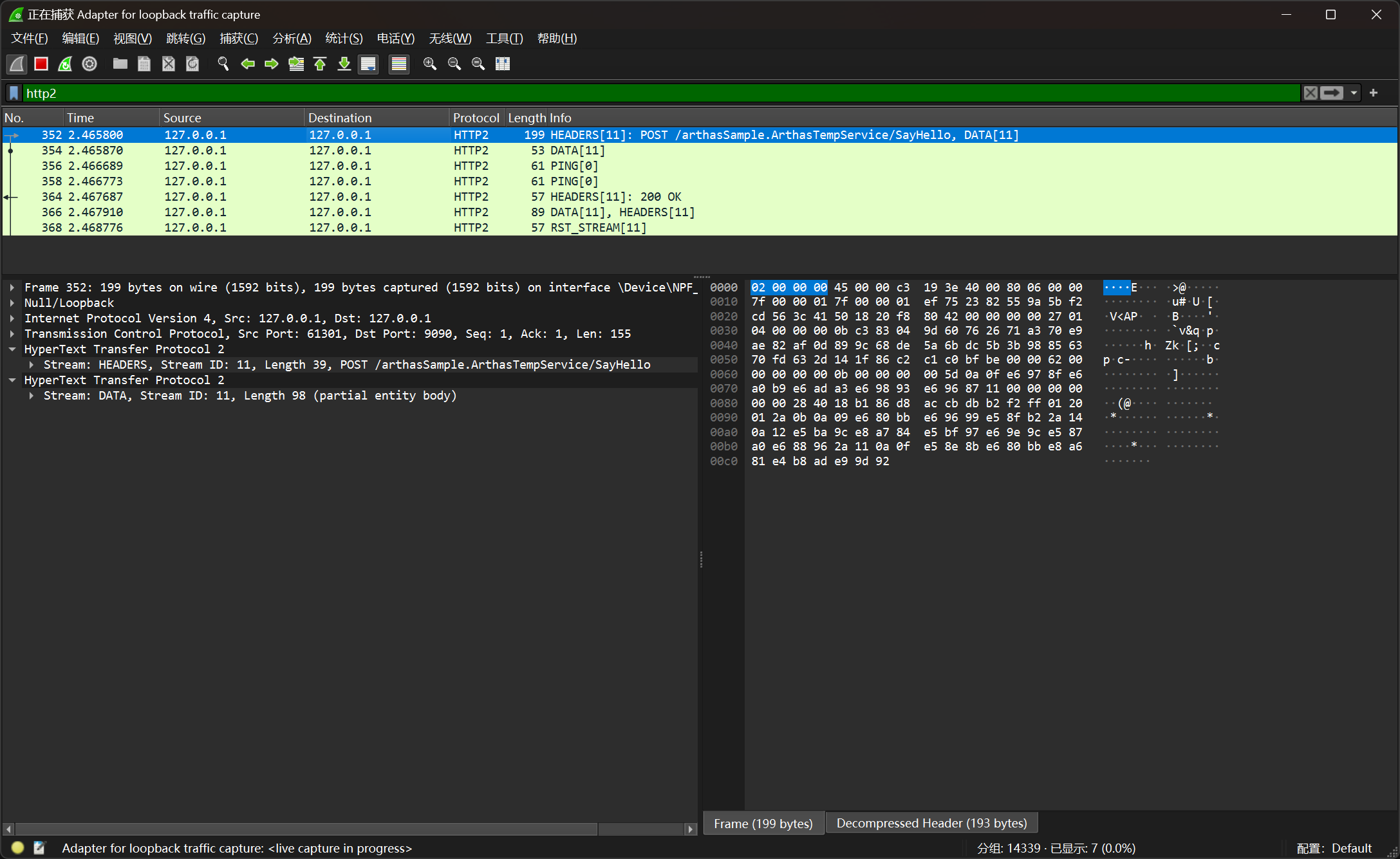
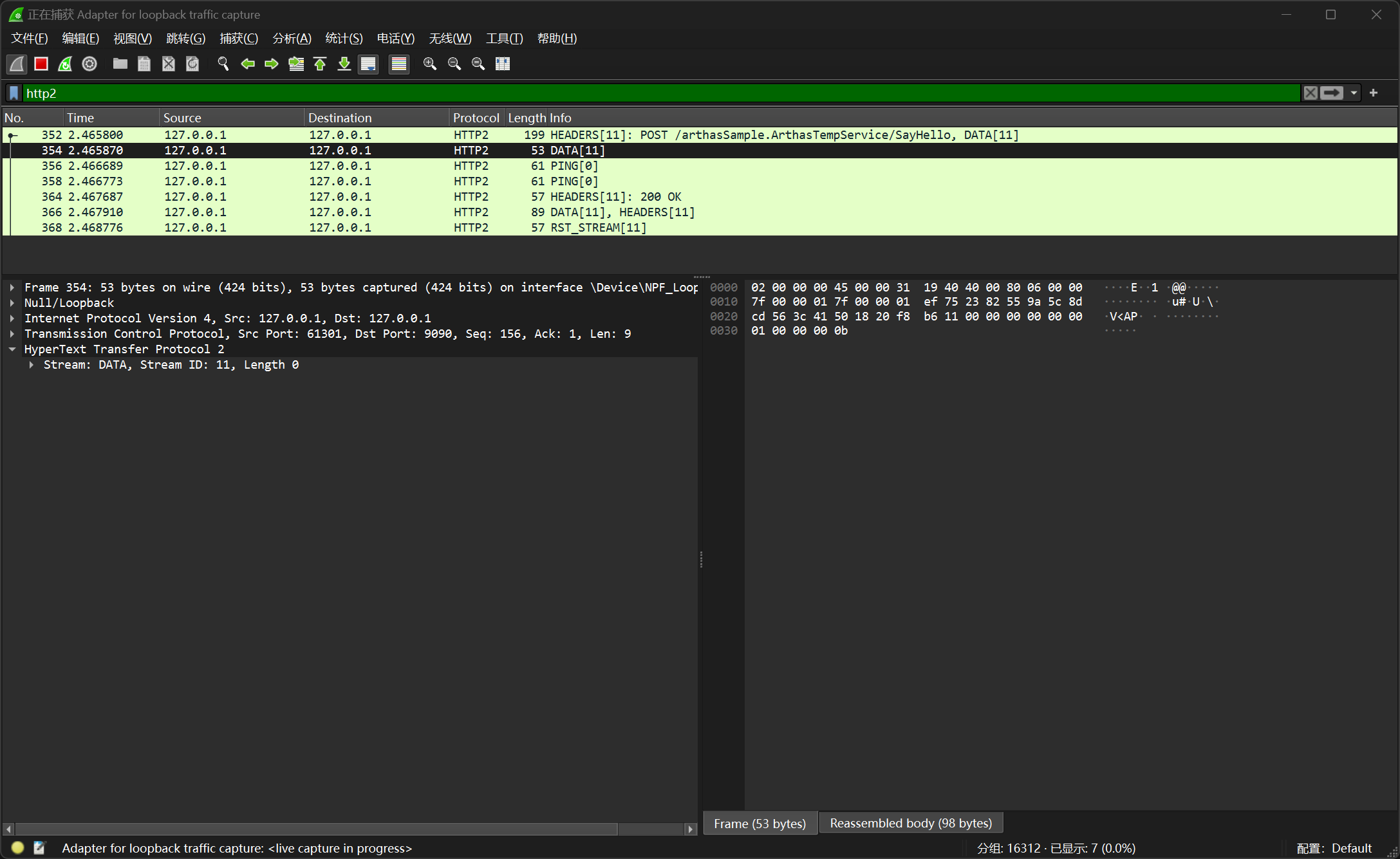
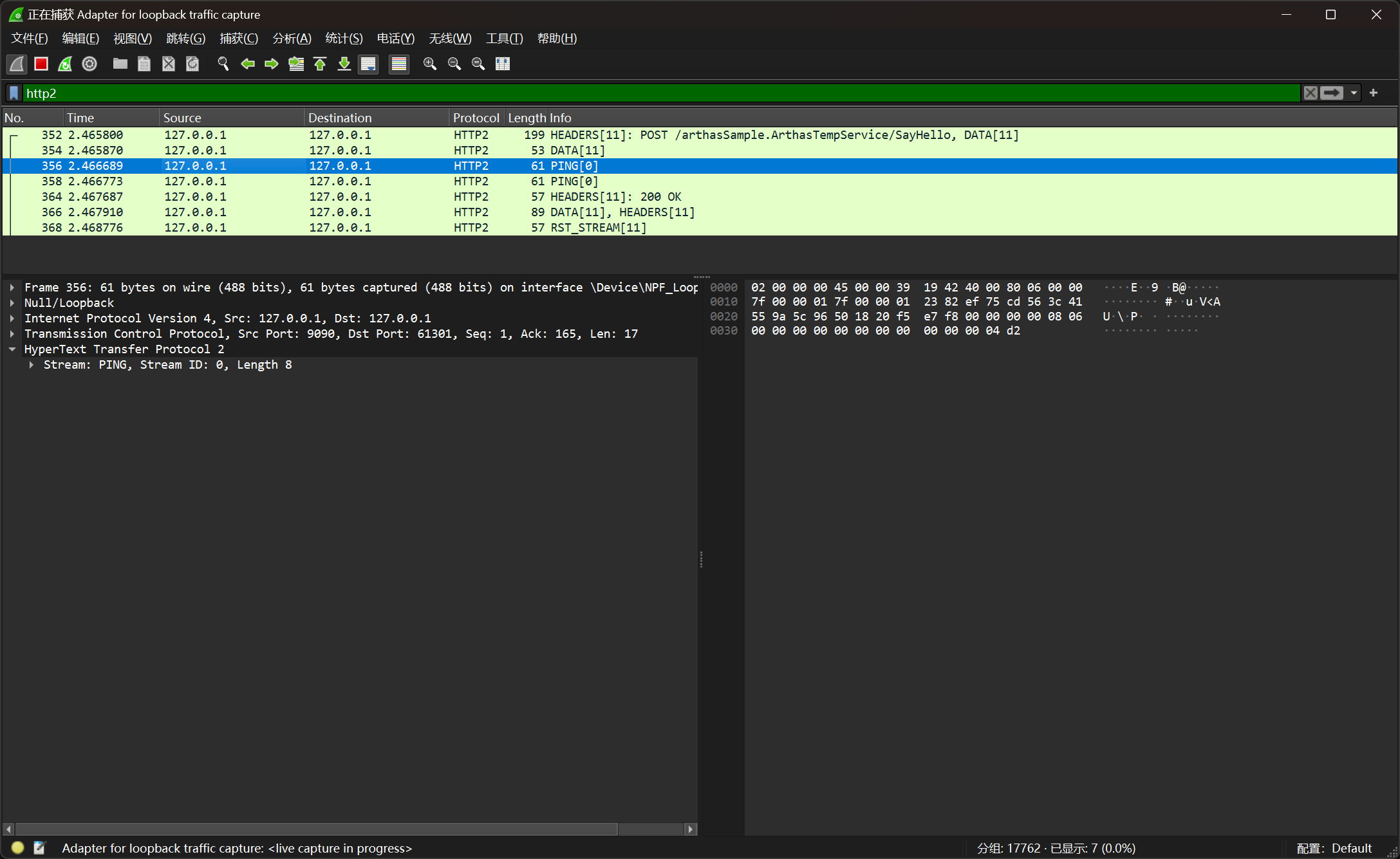
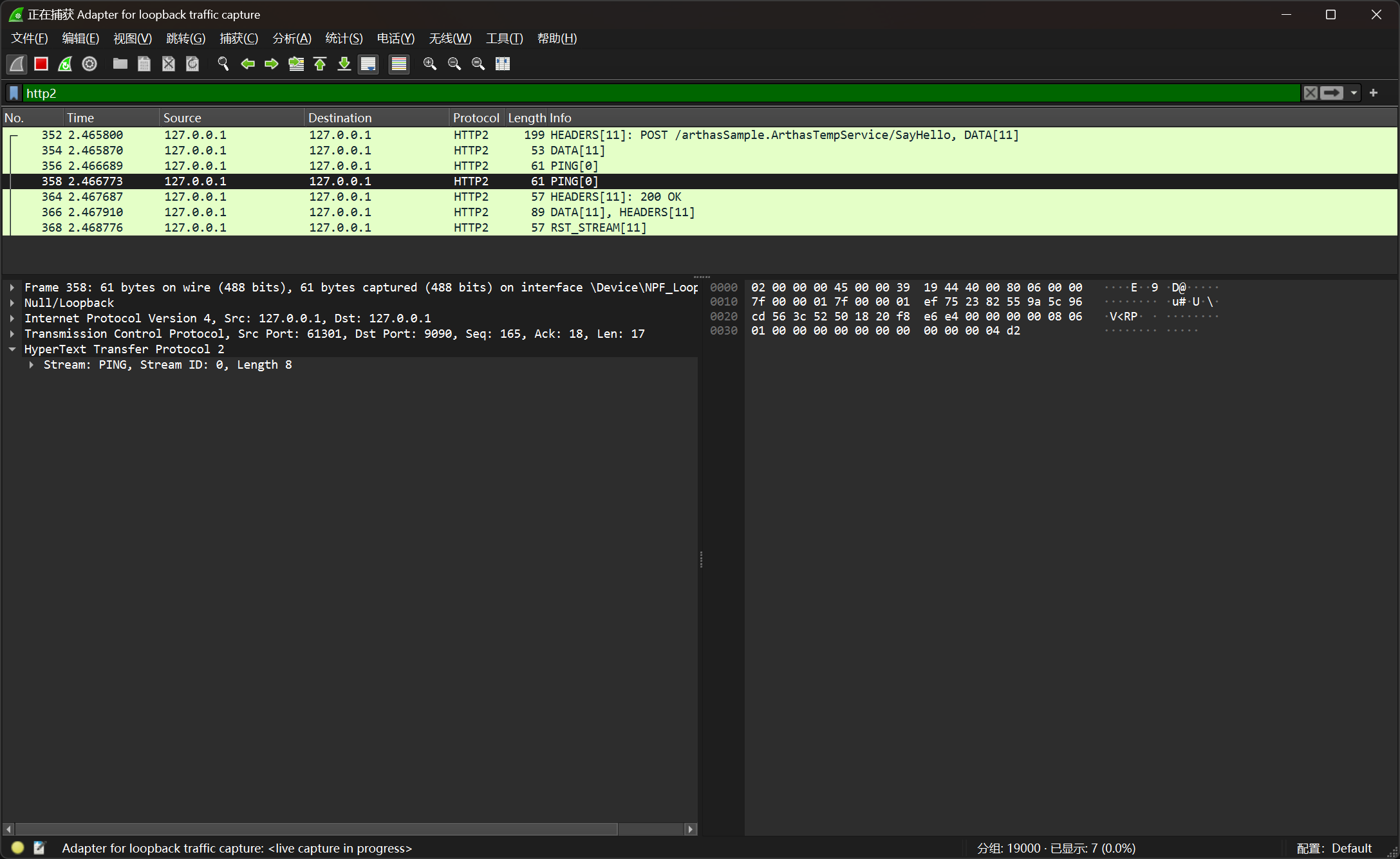
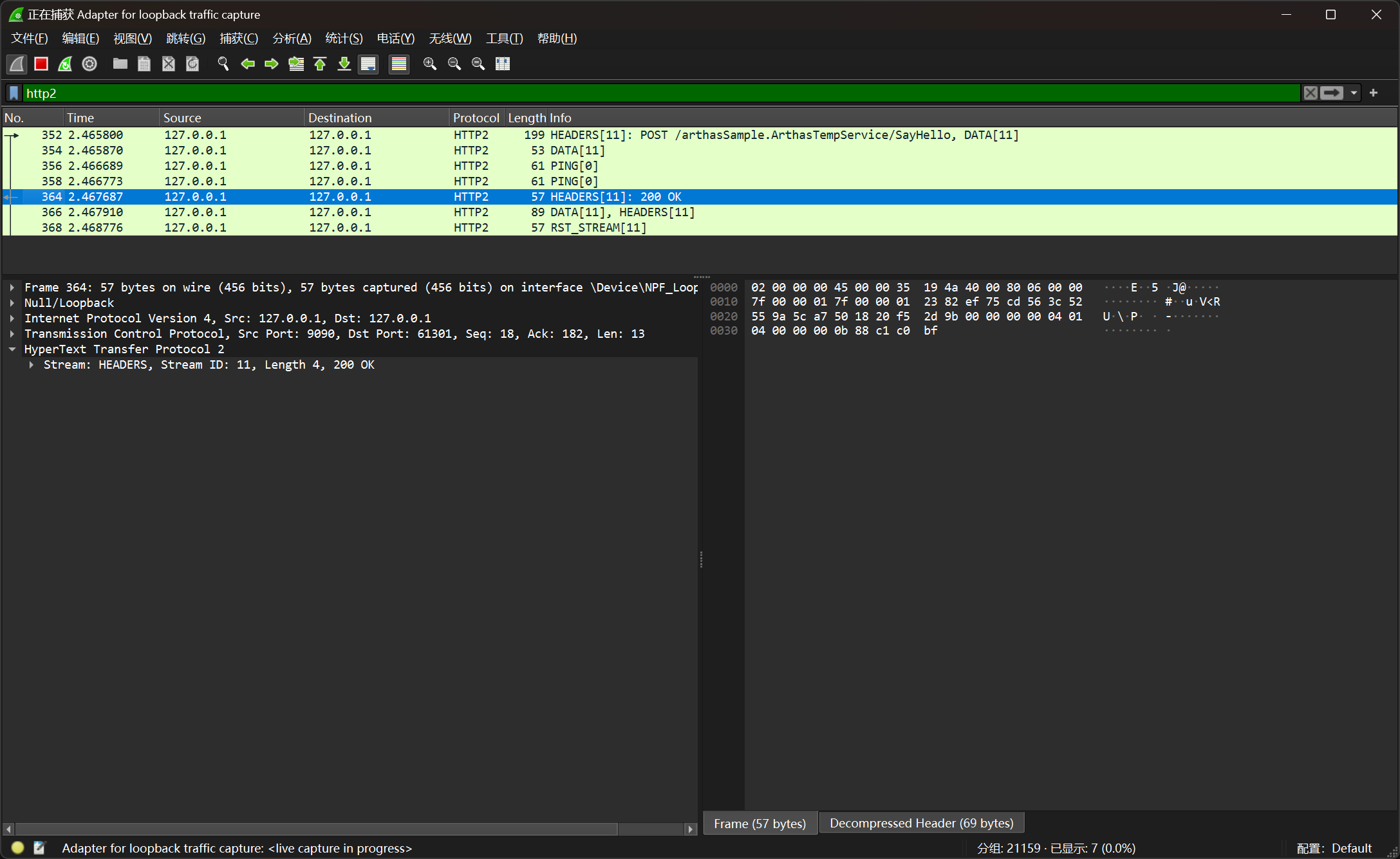
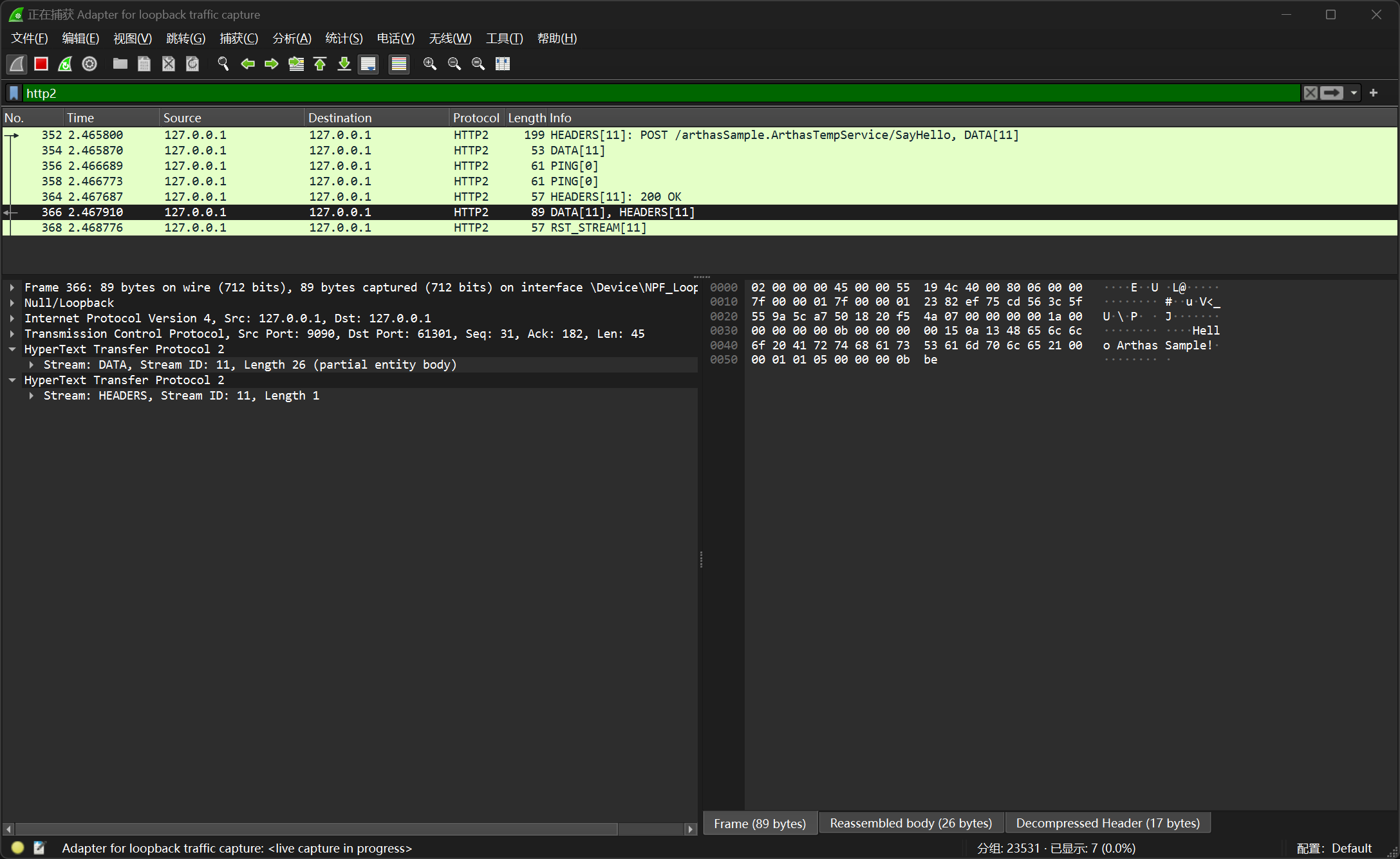
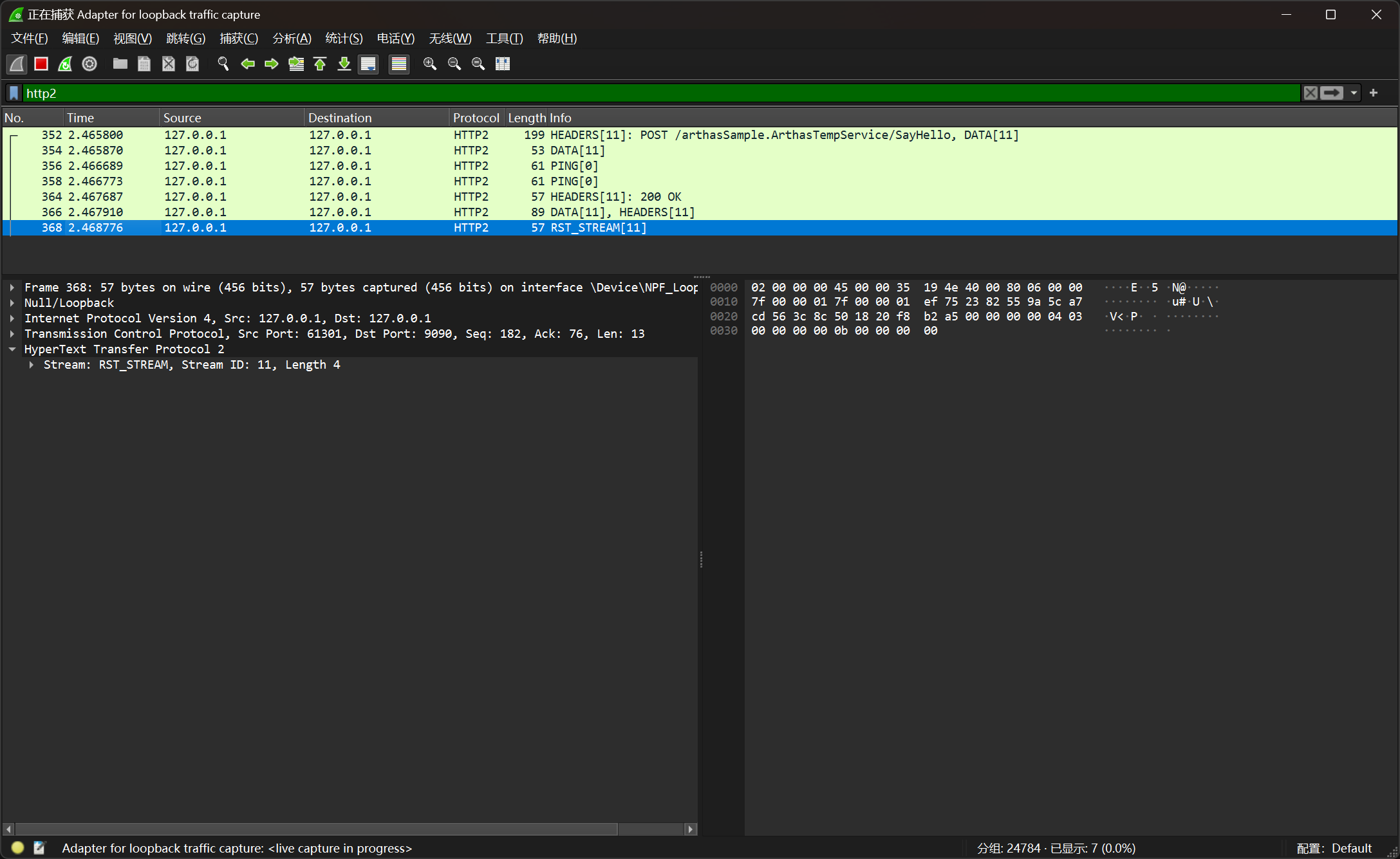
在上图中可以发现一次 grpc 请求的请求响应过程大概如下:
- 客户端向服务端发送 http2 frame,其中附带了一个 header 和一个 data
- 客户端向服务端发送一个空的 data frame,表示流结束(end stream)
- 服务端向客户端发送 ping
- 客户端响应服务端 pong
- 服务端响应客户端请求,其中附带了一个 heade
- 服务端响应客户端请求,其中附带了一个 data 和一个 header
- 客户端发送 RST_STREAM,结束请求
其中 34 netty 会自动处理,主要看请求的接受和发送。
client 发送请求时,除了正常的附带数据的 http2 data frame 外,还会附带一个标识流结束的 http2 data frame;server 响应请求时,还会附带两个 header。
1 | private void handleGrpcData(Http2DataFrame dataFrame, ChannelHandlerContext ctx) throws IOException { |
对于一元调用,需要在收到 end stream 的 frame 时才响应;对于双向 stream 调用,则每次都需要响应。
结果验证
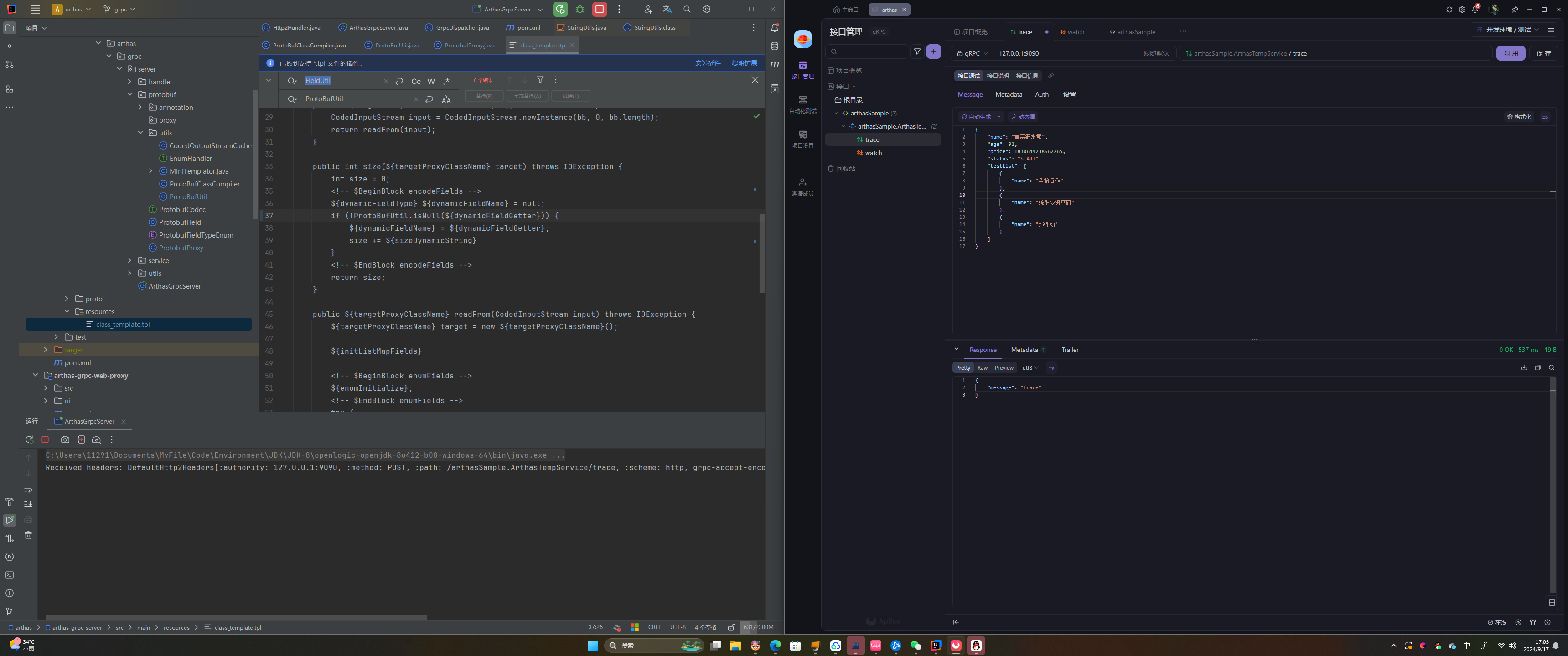
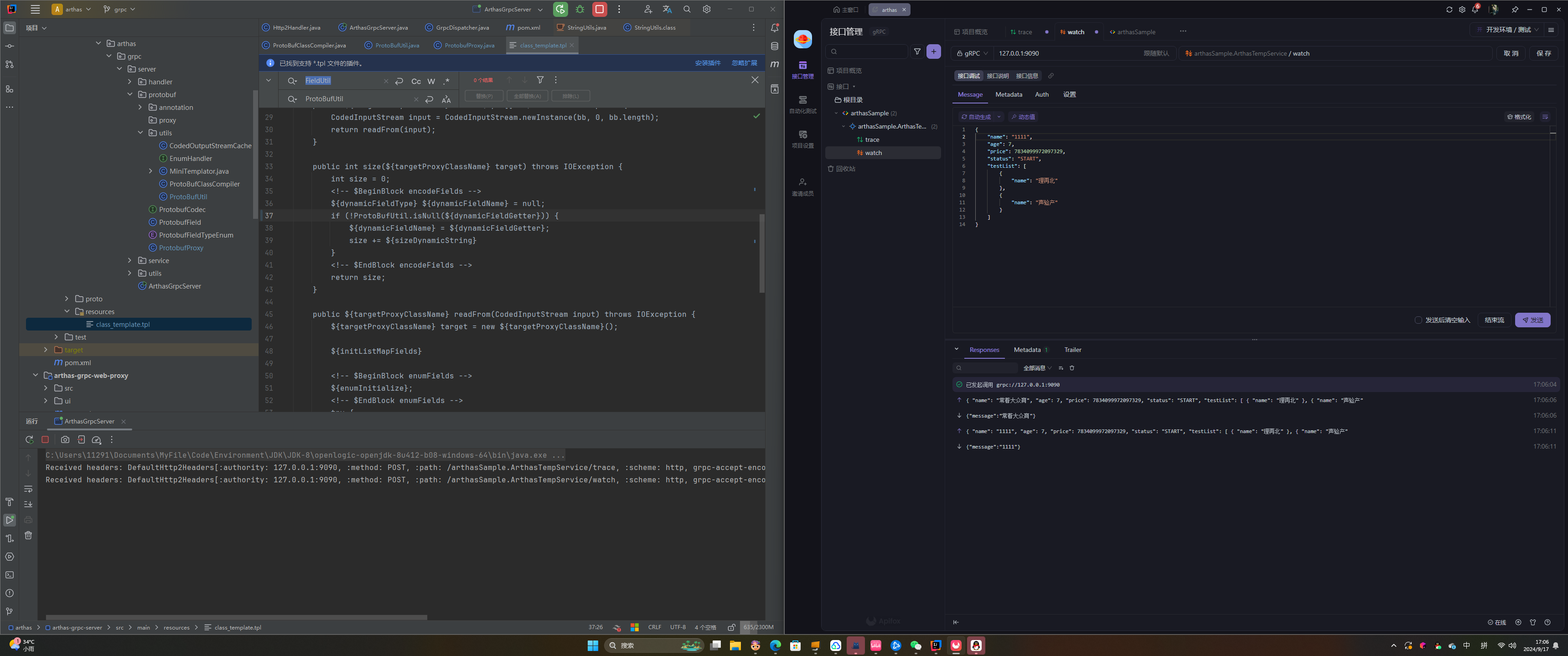
开发完毕后,使用 apifox 针对服务发起调用,验证结果符合预期;
此外也在项目中提供了针对于 protobuf 序列化的单元测试和 grpc 请求的测试方法。经验证,同样符合测试预期。
后续计划
- 在项目编写过程中主要考虑的问题是去除外部依赖,对于性能优化研究的还不够深入。后续需要继续深入优化性能。
- 由于时间问题,只是提供了一个实现了 grpc 协议的处理框架,但是并未实现某个具体的 arthas 功能。后续需要继续深入实现 arthas 的功能。
- 对于某些 grpc 实现细节还没有深入研究,例如 gzip 的解析、http2 协议的升级等等。后续需要继续投入。
个人总结
在这次项目过程中,我深入了解了 HTTP/2 和 gRPC 协议,学习了如何使用 Wireshark 抓包以观察二进制数据,同时掌握了 Netty 的编写与使用。此外,在借鉴 jprotobuf 的过程中,我对 Java 编译的相关知识也有了更深刻的认识。在编写 gRPC 调用路由的过程中,我更深入地理解了 Java 的方法句柄及其应用。这是我首次参与大型开源项目,借此机会,我不仅提升了自己的技术能力,也拓宽了视野。衷心感谢 OSPP 提供的这个宝贵机会,让我在实践中受益良多。